Relationship Spread #2
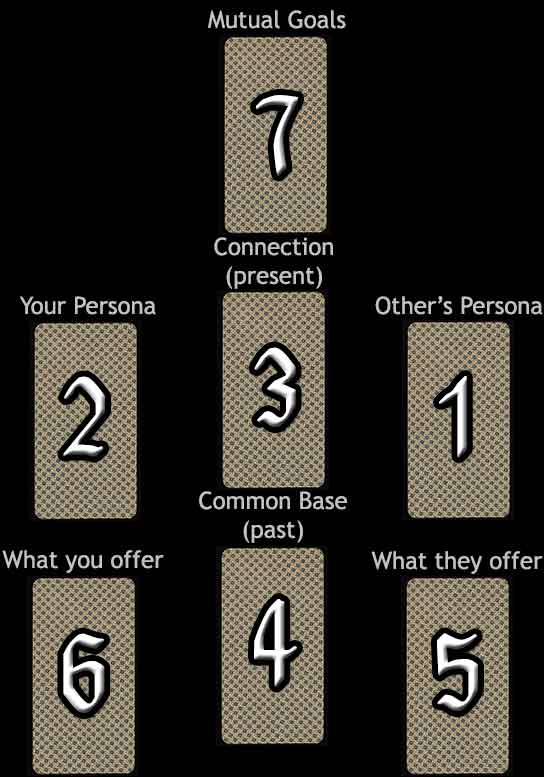
Difficulty: Easy
This relationship spread focuses more on the common ground of the relationship, with three cards in the middle column showing the common ground. The middle column essentially displays the past, present, and future of the relationship.
Card #4 stands for the common base of the relationship, which may be thought of as the past events which have shaped their characters, bringing them together. The current connection that binds them together is Card #3, indicating the values shared. Card #7 implies the common goals that would keep the pair together moving into the future.
The columns on either side show what each partner brings to the table. Remember, relationships need not be romantic, and the partners could even be groups rather than individuals. In this layout, the other person is on the left-hand side and the reader on the right.
Cards #1 & #2 indicate the separate personalities of each member of the relationship. These cards form a sort of bridge with the cards beneath them, #5 & #6, which show the qualities that each partner offers the other person, and thus to the relationship as a whole.
Your Relationship #2 Reading
Mutual Goals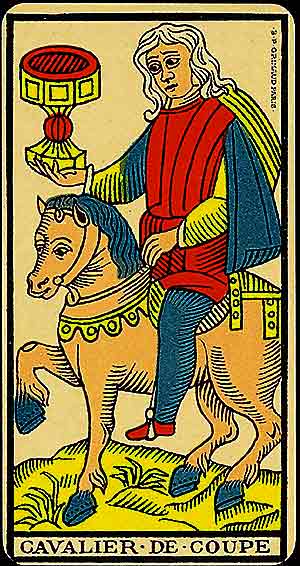 |
||
Your Qualities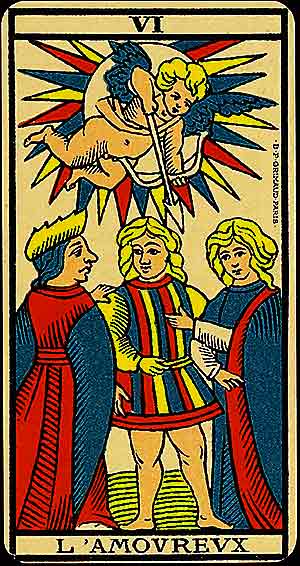 |
Connection (Present)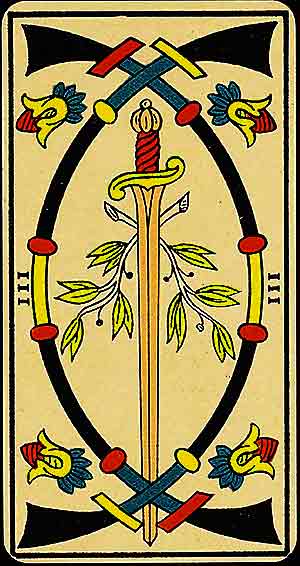 |
Others' Qualities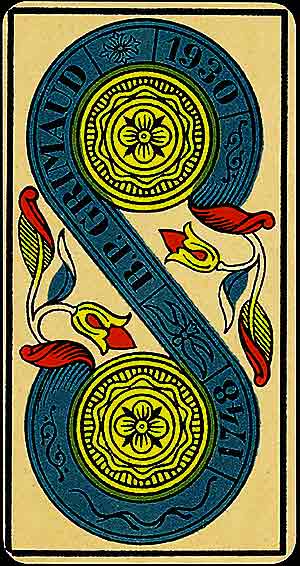 |
What You Bring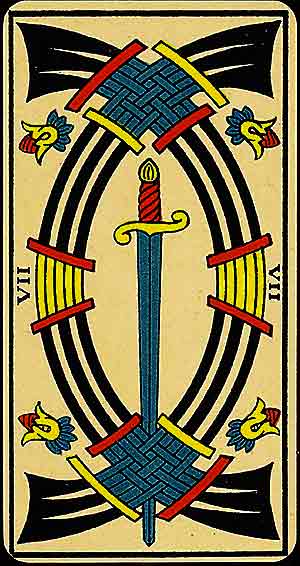 |
Common Base (Past)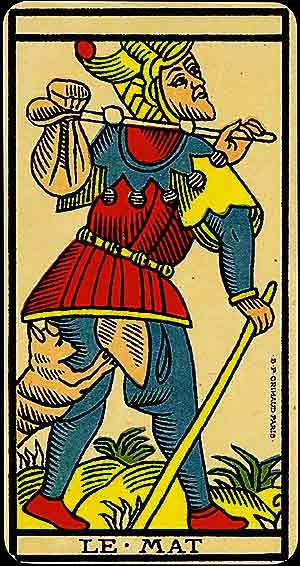 |
What They Bring 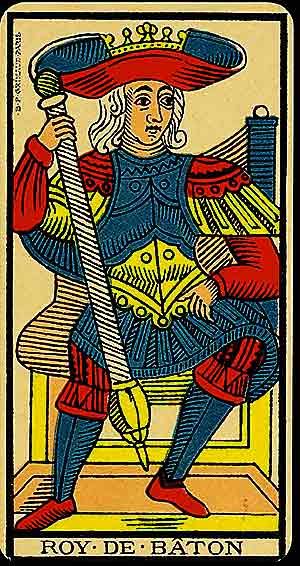 |

7: Mutual Goals
Knight of Cups
The Knight of Cups represents the pursuit of emotional and creative fulfilment, guided by intuition and romantic ideals. He encourages action aligned with your heart while remaining mindful of over idealism or escapism.
Symbolism: The Knight rides a steady horse, presenting a cup as if offering his heart or inspiration. His calm and focused expression reflects his dedication to his emotional or creative quest, while the horse's motion suggests steady progress.
In Relationships: This card signifies romance, devotion, or deepening emotional bonds. It encourages pursuing love with sincerity and charm but warns against being overly idealistic.
In Work: The Knight highlights the importance of pursuing work that resonates emotionally or creatively. It may suggest bringing artistry and passion to your efforts.
Spiritually: The Knight urges you to follow your heart's guidance and align your actions with your inner emotional truths.
When ill-dignified: Emotional inconsistency, escapism, or being too passive. It cautions against pursuing unrealistic ideals without grounding them in reality.

3: Connection
Three of Swords
The Three of Swords represents heartache, loss, and learning hard lessons. It signifies growth through adversity and the necessity of confronting unfortunate truths.
Symbolism: This card features a single central sword surrounded by an oval frame formed by two curved swords. A central sword stands upright, symbolising clarity, truth, and decisive action, while the encircling swords create a sense of containment or conflict. The presence of floral elements growing from the sword's base suggests that pain and struggle can lead to personal growth and renewal. The structure emphasises resilience, balance, and the ability to overcome emotional hardship through wisdom and perseverance.
In Relationships: A time of heartbreak, betrayal, or separation. Healing comes through acknowledging and processing the pain.
In Work: Disappointment or setbacks in a project or partnership. The card encourages resilience and learning from challenges.
Spiritually: The card signifies the transformative power of emotional trials, urging the seeker to find wisdom in suffering.
When ill-dignified: Lingering grief, self-pity, or refusal to move on. It warns against being trapped by sorrow or blaming others.

4: Common Base
0 – The Fool (Le Mat)
The Fool represents the untamed spirit and unshackled freedom of the soul. He wanders without boundaries, embodying movement, exploration, and detachment from worldly concerns. This card invites us to embrace change and unpredictability with courage and spontaneity.
Symbolism: The dog biting at the Fool's leg symbolises the tension between freedom and earthly constraints. His staff and bundle represent the burdens and wisdom accumulated on life's journey, carried with both carelessness and purpose. The colourful jester's attire signifies his eccentricity and adaptability, while his forward gaze reflects an openness to the unknown.
In Relationships: A new, unpredictable connection or the need for more spontaneity in existing relationships. Beware of recklessness.
In Work: Embarking on a risky or unconventional path, where intuition takes precedence over plans.
Spiritually: The Fool embodies the soul's leap into the vast unknown, trusting the divine order of chaos.
When ill-dignified: Naivety, poor judgement, or a lack of grounding. It warns of becoming aimless or distracted by superficial pursuits.

2: Your Qualities
VI – The Lovers (L'Amoureux)
The Lovers signifies choice, connection, and the interplay between opposing forces. It represents the power of free will in aligning with one's deepest values and desires.
Symbolism: A central figure stands between two others, often interpreted as a choice between duty and desire or contrasting influences. Above, Cupid aims an arrow, symbolising divine inspiration or the fateful pull of love. The figures' expressions suggest conflict and harmony, reflecting the complexity of relationships.
In Relationships: Profound connections, romantic choices, or a pivotal decision within a partnership. It highlights emotional and spiritual harmony.
In Work: A crossroads where important decisions must align with personal values. Collaboration or partnerships may play a key role.
Spiritually: The Lovers calls for integrating dualities—earthly and divine, passion and reason—on the path to wholeness.
When ill-dignified: Indecision, temptation, or imbalance. It warns of superficial attractions or ignoring inner truth in key decisions.

1: Their Qualities
Deuce of Coins
The Deuce of Coins represents balance, adaptability, and the management of priorities. It highlights the flow and rhythm of practical matters.
Symbolism: A blue ribbon bearing the name B.P. Grimaud links two coins, symbolising the interplay between dual forces. The design reflects the need for equilibrium and flexibility in navigating change.
In Relationships: Finding a balance between personal and shared responsibilities.
In Work: Juggling tasks or managing resources effectively. It encourages adaptability in the face of change.
Spiritually: The card represents the balance between spiritual and material pursuits, urging the seeker to maintain harmony.
When ill-dignified: Instability, over-commitment, or neglecting one priority in favour of another. It warns against losing balance in your endeavours.

6: What You Bring
Seven of Swords

5: What They Bring
King of Batons
The King of Batons signifies visionary leadership, mastery of creative energy, and the courage to inspire and guide others. This card represents the fulfilment of ambitions through determination and integrity.
Symbolism: Seated on a throne as a symbol of power and growth, the King holds his baton with authority, exuding confidence. His posture reflects a deep understanding of his role as a leader and creator.
In Relationships: It represents a strong, passionate partnership built on mutual respect and shared goals. The card encourages leading with strength and understanding.
In Work: The King symbolises ambition fulfilled through visionary action, inspiring others, and maintaining integrity. It encourages bold decision-making and confidence in your abilities.
Spiritually: The King reflects mastery of inner fire, urging the seeker to channel their spiritual energy into meaningful action and purpose.
When ill-dignified: Tyranny, arrogance, or a lack of empathy. It warns against using power selfishly or losing sight of the collaborative spirit of true leadership.